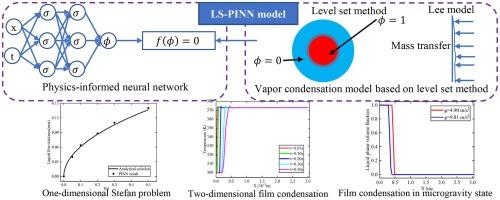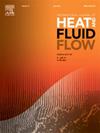Physics-Informed neural network for level set method in vapor condensation
IF 2.6
3区 工程技术
Q2 ENGINEERING, MECHANICAL
International Journal of Heat and Fluid Flow
Pub Date : 2024-11-16
DOI:10.1016/j.ijheatfluidflow.2024.109651
引用次数: 0
Abstract
Vapor condensation, a common physical phenomenon, is a complex multiphase flow problem involving mass transfer and heat transfer, which presents significant challenges in simulation, particularly regarding accuracy and computational efficiency. Hence, to improve simulation accuracy and achieve rapid prediction of condensation-generated water, this paper introduces an LS-PINN model, combining the precision of the level set method (LS) with the efficiency of the physics-informed neural network (PINN). It comprises two main components: i) a more accurate vapor condensation model is constructed by embedding Lee model as source terms into the two-phase flow model based on the level set method. And then the model is validated through the finite element method (FEM). ii) a dimensionless form suitable for PINN is derived of the governing equations (e.g., continuity equation, Navier-Stokes equations (without considering surface tension), heat equation and level set equation). On this basis, the LS-PINN model is constructed by incorporating the governing equations into the loss function, and trained through adaptive weight algorithm and sequential fixed strategy. Finally, three numerical examples are designed to validate the proposed model. The results show that the LS-PINN model can evaluate the liquid film thickness generated by condensation in one-dimensional and two-dimensional situations effectively. Furthermore, the total training time for the LS-PINN models is no more than 30 h, whereas the finite element calculation time takes approximately 130 h. The prediction time, which is measured in milliseconds, makes the PINN model highly suitable for applications where immediate responses are crucial, such as in digital twin systems.

用于蒸汽凝结中水平集法的物理信息神经网络
蒸汽凝结是一种常见的物理现象,是一个涉及传质和传热的复杂多相流问题,给模拟带来了巨大挑战,尤其是在精度和计算效率方面。因此,为了提高模拟精度并实现对凝结水的快速预测,本文介绍了一种 LS-PINN 模型,该模型结合了水平集法(LS)的精度和物理信息神经网络(PINN)的效率。它包括两个主要部分:i) 通过将 Lee 模型作为源项嵌入到基于水平集法的两相流模型中,构建了一个更精确的蒸汽凝结模型。然后通过有限元法(FEM)对模型进行验证。ii)推导出适用于 PINN 的无量纲形式的控制方程(如连续性方程、纳维-斯托克斯方程(不考虑表面张力)、热方程和水平集方程)。在此基础上,通过将控制方程纳入损失函数来构建 LS-PINN 模型,并通过自适应权重算法和顺序固定策略进行训练。最后,设计了三个数值示例来验证所提出的模型。结果表明,LS-PINN 模型能有效评估一维和二维情况下冷凝产生的液膜厚度。此外,LS-PINN 模型的总训练时间不超过 30 小时,而有限元计算时间约为 130 小时。以毫秒为单位的预测时间使 PINN 模型非常适合数字孪生系统等需要即时响应的应用。
本文章由计算机程序翻译,如有差异,请以英文原文为准。
求助全文
约1分钟内获得全文
求助全文
来源期刊

International Journal of Heat and Fluid Flow
工程技术-工程:机械
CiteScore
5.00
自引率
7.70%
发文量
131
审稿时长
33 days
期刊介绍:
The International Journal of Heat and Fluid Flow welcomes high-quality original contributions on experimental, computational, and physical aspects of convective heat transfer and fluid dynamics relevant to engineering or the environment, including multiphase and microscale flows.
Papers reporting the application of these disciplines to design and development, with emphasis on new technological fields, are also welcomed. Some of these new fields include microscale electronic and mechanical systems; medical and biological systems; and thermal and flow control in both the internal and external environment.
 求助内容:
求助内容: 应助结果提醒方式:
应助结果提醒方式:


